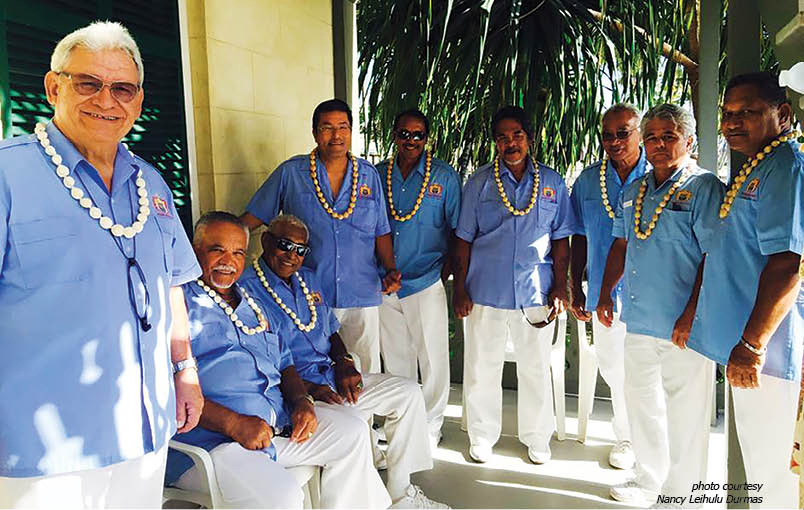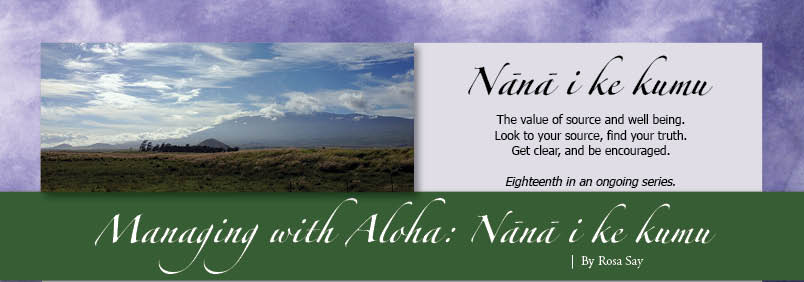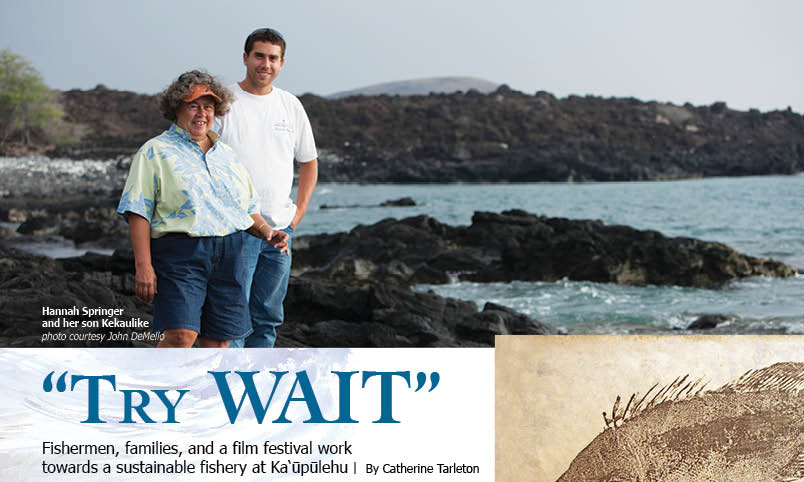
The Merrie Monarchs of Hulihe‘e Palace: The Men Who Sing for the King

By Karen Valentine
A group of men who love music and love to sing Hawaiian songs gathers together on one Sunday each month to sing their hearts out on the lānai at Hulihe‘e Palace in Kailua-Kona. They have staying power, having been doing it for nearly 40 years. The Merrie Monarchs are named after a beloved Hawaiian King, David Kalākaua, who loved music, especially concert band music, and also composed a number of songs in Hawaiian that remain popular today. He was often called “The Merry Monarch” because he so enjoyed entertainment.
Three members of the original group of about 13 or 14 men remain today, including Joe Spencer, the group’s leader since 1976.
The story of the Merrie Monarchs is closely tied with that of the Hulihe‘e Palace Band, founded in 1976 by Charles G. “Bud” Dant. Bud was a band leader, composer and record producer who worked with famous stars in early radio and TV. He served for a time as producer for Hawaii Calls, the old Hawaiian music radio show, and produced albums for Hawaiian performers such as Alfred Apaka and Melveen Leed.
Bud moved to Kailua-Kona to retire in 1975 and right away started looking for something to do in music for Kona.
“He came to speak with the Daughters of Hawai‘i at Hulihe‘e Palace,” says Joe Spencer. “His concept was that he could do band concerts here, similar to what King Kalākaua did. Aunty Lei Collins, curator of the palace at that time, encouraged him to go ahead.”
Bud emphasized that these concerts would honor the palace, historical Hawaiian music, and the era of the monarchy.
“The highlight of the music would be monarchy-era songs—songs that were either authored by the Hawaiian Ali‘i or honored the Ali‘i,” said Joe.
The first concert was held on June 11, 1976, Kamehameha Day.
A newspaper clipping from the Honolulu Advertiser announcing the event reads “A main feature of the opening program will be the premiere performance of several of Bud’s arrangements of Hawaiian compositions for concert band.”
“There is really no repertoire of Hawaiian music for concert band,” Bud is quoted. “Only a few songs, like Hawai‘i Pono‘ī, have ever been arranged.” Bud goes on to say he arranged 15 Hawaiian songs for the new band. “The Kamehameha Day concert will feature an appearance by ‘Iolani Luahine, the acknowledged first lady of Hawaiian dance.”
A 1977 feature story about Bud in West Hawaii Today reads, “He took about six months to pull the band into good enough shape so that it could debut on Kamehameha Day in June. The band is unique in that it only plays music of the Hawaiian royalty era, songs composed by or about members of the monarchy. However, before he could even start rehearsal, Bud had to write down the songs, as many of them had never been recorded on paper. He would get people—one of them popular oldtimer Charles K.L. Davis—to sing a song and Bud would write it down. He also had to dig through a lot of old books in which only the words of the songs were written and try to put two and two together. Sometimes the tunes that were written were not recorded correctly, and nobody’s sure exactly how every note goes.”
“He wrote the music for each instrument,” says Joe. “The band today, as it exists, uses the same music for their concerts.”
Bud Dant died in 1999 at age 92.
‘Iolani Luahine performed a Hawaiian chant blessing to open the first concert. Songs included:
- Hawai‘i Pono‘ī, the state song and former national anthem written in 1874 by King Kalākaua and Henri Berger, leader of the Royal Hawaiian Band;
- Overture
- Kamehameha Waltz written by Charles E. King in 1915;
- Kalele O Nalani by the Daughters of Hawai‘i;
- Koni Au Ika Wai by King David Kalākaua;
- Ku‘u Pua I Paoakalani by Queen Lili‘uokalani;
- Kona Kai ‘Opua written by Henry Waiau about Kona and also a love story of Liholiho, Kamehameha II;
- Kaulana Nā Pua written in 1893 by Ellen Prendergast at the request of members of the Royal Hawaiian Band; it was intended to oppose the annexation of Hawai‘i to the United States and support Queen Lili‘uokalani;
- Ua Like No A Like by Alice Everett, a contemporary of Queen Lili‘uokalani; and
- Hawai‘i Aloha written in the late 1880s by Reverand Lorenzo Lyons.
“After the first concert, [Bud] thought he needed a vocal component in addition to the band,” Joe says. “Somebody suggested he talk to Uncle Donna Kuali‘i, who was promotions manager for Aloha Airlines. Uncle Donna said ʻWell, there is a group of local boys. We have a club here in Kona called the Civitan Club.’ Uncle Donna brought the proposal to us and we said, ʻYes, why not?,’” says Joe, who was a member of that club.
“Then Uncle Donna looked at me and said, ‘Youʻre going to be the leader. I said, ‘Uncle Donna, I don’t have any music background. I can sing, thatʻs all.’ He says, ‘That’s all right, youʻre going to do it.’ So we did it and that’s where it started. Bud gave us the name.”
The Merrie Monarchs Hawaiian Men’s Glee Club joined the second official concert in July 1976. Joe estimates the first group consisted of 13 or 14 members. The only woman singing with the band, he says, was Grace Basque, a lyric soprano.
“She sang with the waltzes and also performed as part of the original hula troupe, doing the kahiko hula portion at the concerts. She and several others danced with Aunty ‘Iolani Luahine.”
The group has continued ever since with monthly concerts on the ocean lānai at Hullihe‘e Palace. They sing for the love of the music; there is no charge.
“Our intent is to perpetuate the monarchy era music and also our Hawaiian culture. Next year will be our 40th year,” Joe says.
“After a time, Bud suggested that we do some tunes with our own instruments, our ‘ukulele. Then later he told us, ‘What I’d like to see is that you folks take some of the concerts on your own and do a hula concert.’ So we did that with Kumu Etua Lopez and his hālau. Starting in 1991, we performed music with ‘auana hula. We would sing first with the band, then do our own interpretations with Hawaiian music.”
In alignment with the formal and historic nature of the concert, the attire of the band members consists of all-white pants and shirts with red cummerbunds.
“We wore black pants and white safari shirts with our insignia at first,” says Joe. When the group started doing its own repertoire, “we changed our uniform to the powder-blue shirt, white pants, white shoes, and kukui nut lei.”
Asked about other monarchy-era songs that the Merrie Monarchs perform, Joe reports, “A song we sing with the band for example is Na Ali‘i, written by Samuel Kuahiwi [1930] about our monarchs. It calls for all of us to come together and honor the Ali‘i of the past. And from Kalākaua’s music, we start always with Hawai‘i Pono‘ī. One of our standard songs has been Koni Au I Ka Wai, another Kalākaua song, and Kokohi by Queen Lili‘uokalani.”
One of Joe’s tasks as the leader, he says, was to write the words out in longhand, copied from the music sheets. The ensemble sings in three, four, or five part harmony, depending on the song.
“Most of Hawaiian music is based on three-part harmony. During our tenure we have had a number of well-known musicians participate with us, for example ‘Square’ (Joseph) Kalima and his brother Puni. They were part of the Kalima Brothers group. Others were Uncle John A‘una, who played steel guitar at the Hilton, now the Royal Kona Resort. To me, the Merrie Monarchs came from a group of men that just liked to sing Hawaiian songs. That is the premise on which we organized. There is no formal training. Everyone brought what he knew and we put it together. We always kept uppermost in mind that Hulihe‘e Palace was an important part of our history and through our singing we could perpetuate that.”
Today he says there are a total of 16 to 18 men, not all of them active. They hold weekly rehearsals in the Keauhou Shopping Center maintenance shop, where Joe worked before retiring from Bishop Estate (Kamehameha Investment Corp).
The Merrie Monarchs Men’s Hawaiian Glee Club has produced two albums, “The Merrie Monarchs at Keauhou Bay” and “Christmas in Kailua-Kona,” which they sell at their concerts.
Each “Afternoon at Hulihe‘e” concert honors one of Hawai‘i’s past monarchs or historical figures. They are held on the third Sunday of each month, except for Hawaiian holidays that honor Ali‘i, such as Kamehamehaʻs birthday, Kalākaua’s birthday, and the birthday of Governor Kuakini, who built the palace as his mansion in 1838. Admission is free—donations are appreciated. It is recommended that you bring a beach mat or chair as seating is not provided.
“We also perform at functions outside the palace. It’s a voluntary thing, with nobody getting paid,” Joe says. The Merrie Monarchs have represented the Hawai‘i Visitors Bureau during several trips to visitor industry conferences on the mainland; they have offered free concerts for the annual Merrie Monarch Festival in Hilo, and also at palace fundraisers.
“There is turnover from time to time,” Joe said. “A number have passed on and new ones come in. As long as they like to sing Hawaiian music, we’re open to having them come and participate. We become tightly knit in our music.” ❖
Upcoming Hulihe‘e Palace concert dates
Sunday, November 15—Celebrating King Kalākaua’s birthday, remembering Aunty Lei Collins and Charles “Bud” Dant
Sunday, December 13—Celebrating Princess Bernice Pauahi Bishop
June 2016—100-year anniversary of Hulihe‘e Palace and the 40-year anniversary of the Merrie Monarchs
Current roster of the Merrie Monarch Men’s Glee Club, including the year each joined, and their other public music activities.
- Alan Hale (2006), Teaches ukulele; plays in a group at Akule Supply Restaurant on Keauhou Bay.
- Chauncey Wong Yuen (1994), Part of the promotion team team for Hawaiian Airlines for many years.
- Donna Kuali‘i (1976), Hawaiian music entertainer for many years.
- Francis Lee (1992)
- Grant Kobayashi (2003)
- Harold “Ollie” Olinger (1994)
- Henry Chapman (1986)
- Herb Deaguiar (1992)
- Joe Spencer (1976)
- Micah Deaguiar (2002), Music instructor, “a rising talent in Hawaiian falsetto” says Joe Spencer.
- Peter Gandalera (1992)
- Reginald Davis (2012), Professional entertainer, host of the Royal Kona Resort lū‘au.
- Robert “Kona Bob” Stoffer (2005), Steel guitarist, and instrument maker.
- Robert Nishida (1996), Local guitarist, an entertainer at Mauna Lani Resort.
- Rupert Adarme (2011), Local entertainer with groups such as Island Breeze and others.
- William Kaopuiki (1992)
Contact Joe Spencer
Contact the writer


